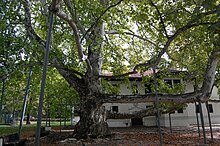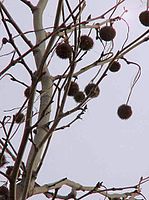
In biology, a hybrid is the offspring resulting from combining the qualities of two organisms of different varieties, species or genera through sexual reproduction. Generally, it means that each cell has genetic material from two different organisms, whereas an individual where some cells are derived from a different organism is called a chimera. Hybrids are not always intermediates between their parents, but can show hybrid vigor, sometimes growing larger or taller than either parent. The concept of a hybrid is interpreted differently in animal and plant breeding, where there is interest in the individual parentage. In genetics, attention is focused on the numbers of chromosomes. In taxonomy, a key question is how closely related the parent species are.
Sycamore is a name which has been applied to several types of trees, but with somewhat similar leaf forms. The name derives from the ancient Greek συκόμορος (sūkomoros) meaning "fig-mulberry".
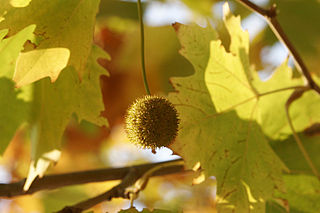
Platanaceae, the "plane-tree family", is a family of flowering plants in the order Proteales. The family consists of only a single extant genus Platanus, with twelve known species. The plants are tall trees, native to temperate and subtropical regions of the Northern Hemisphere. The hybrid London plane is widely planted in cities worldwide.

Platanus is a genus consisting of a small number of tree species native to the Northern Hemisphere. They are the sole living members of the family Platanaceae.
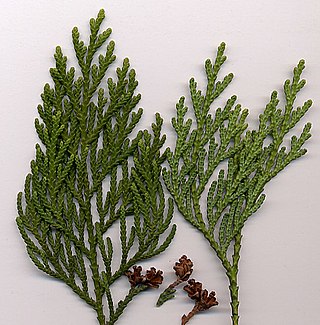
Thuja is a genus of coniferous tree or shrub in the Cupressaceae. There are five species in the genus, two native to North America and three native to eastern Asia. The genus is monophyletic and sister to Thujopsis. Members are commonly known as arborvitaes, thujas or cedars.

Cornus florida, the flowering dogwood, is a species of flowering tree in the family Cornaceae native to eastern North America and northern Mexico. An endemic population once spanned from southernmost coastal Maine south to northern Florida and west to the Mississippi River. The tree is commonly planted as an ornamental in residential and public areas because of its showy bracts and interesting bark structure.

Malus is a genus of about 32–57 species of small deciduous trees or shrubs in the family Rosaceae, including the domesticated orchard apple, crab apples and wild apples.

Platanus orientalis, the Old World sycamore or Oriental plane, is a large, deciduous tree of the Platanaceae family, growing to 30 m (98 ft) or more, and known for its longevity and spreading crown. In autumn its deep green leaves may change to blood red, amber, and yellow.

Platanus occidentalis, also known as American sycamore, American planetree, western plane, occidental plane, buttonwood, and water beech, is a species of Platanus native to the eastern and central United States, the mountains of northeastern Mexico, extreme southern Ontario, and extreme southern Quebec. It is usually called sycamore in North America, a name which can refer to other types of trees in other parts of the world. The American sycamore is a long-lived species, typically surviving at least 200 years and likely as long as 500–600 years.
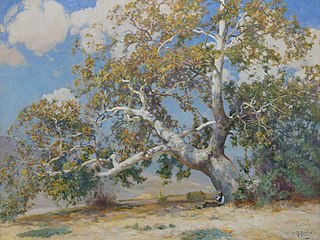
Platanus racemosa is a species of plane tree known by several common names, including California sycamore, western sycamore, California plane tree, and in North American Spanish aliso. Platanus racemosa is native to California and Baja California, where it grows in riparian areas, canyons, floodplains, at springs and seeps, and along streams and rivers in several types of habitats. It can be found as far north as Tehama and Humboldt counties.

Acer pseudoplatanus, known as the sycamore in the British Isles and as the sycamore maple in the United States, is a species of maple native to Central Europe and Western Asia. It is a large deciduous, broad-leaved tree, tolerant of wind and coastal exposure.
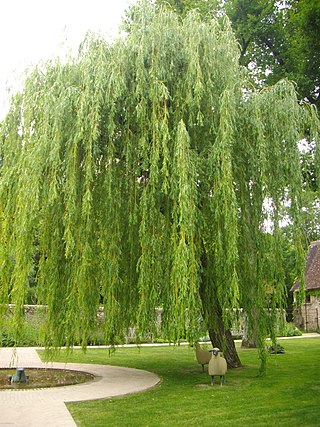
Salix babylonica is a species of willow native to dry areas of northern China, but cultivated for millennia elsewhere in Asia, being traded along the Silk Road to southwest Asia and Europe.

Vitis rupestris is a species of grape native to the United States that is known by many common names including July, Coon, sand, sugar, beach, bush, currant, ingar, rock, and mountain grape. It is used for breeding several French-American hybrids as well as many root stocks.
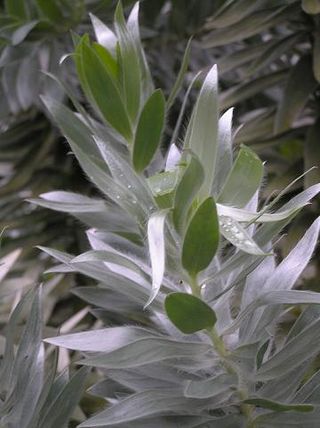
Leucadendron is a genus of about 80 species of flowering plants in the family Proteaceae, endemic to the Cape Provinces and KwaZulu-Natal in South Africa, where they are a prominent part of the fynbos ecoregion and vegetation type.

The Siberian elm cultivar Ulmus pumila 'Hansen' is a little-known American tree of obscure origin, possibly raised from seed collected by the horticulturist and botanist Prof. Niels Hansen during his expedition to Siberia in 1897.

The hybrid elm cultivar Ulmus 'Den Haag' is a Dutch development derived from a chance crossing of the Siberian Elm cultivar Ulmus pumila 'Pinnato-ramosa' and the Belgian Elm Ulmus × hollandica 'Belgica'. S. G. A. Doorenbos (1891-1980), Director of Public Parks in The Hague, finding that seeds he had sown in 1936 from the Zuiderpark 'Pinnato-ramosa' had hybridized with the local 'Belgica', selected six for trials. The best was cloned and grafted on 'Belgica' rootstock as 'Den Haag'; it was planted first in that city, then released to nurseries elsewhere in the Netherlands. The other five were also planted in The Hague.

Corythucha ciliata, the sycamore lace bug, is a species of lace bug in the family Tingidae that is associated with sycamore trees.
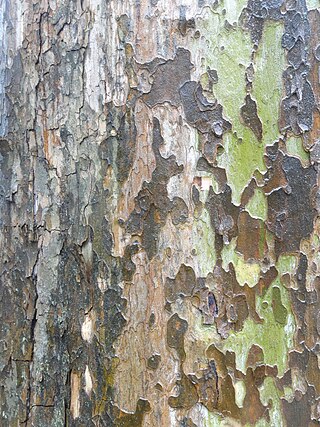
Ceratocystis platani is a fungus that causes a disease on plane trees in the genus Platanus, mostly in North America and Southern Europe.

Lathyrus belinensis, also known as the Belin pea is a flowering plant species in the genus Lathyrus under the family Fabaceae. The species was discovered in Turkey by botanists Nigel Maxted and David John Goyder and was first described in 1988. The species is a highly localized endemic found only in the Turkish province of Antalya. L. belinensis was listed among the top one hundred most endangered species of the world by the IUCN in 2012.

Platanus rzedowskii, commonly known as Rzedowski's plane tree, Rzedowski's sycamore, Sicómoro de la Sierra Madre Occidental, or the Sierra Madre Occidental sycamore, is a species of Platanus in the family Platanaceae. It was described by Jackie M. Poole in 2003 with the name attributed to Kevin C. Nixon.





